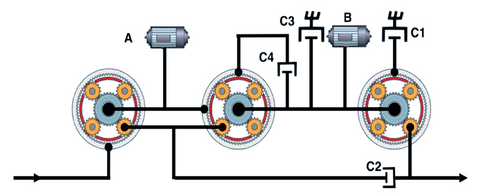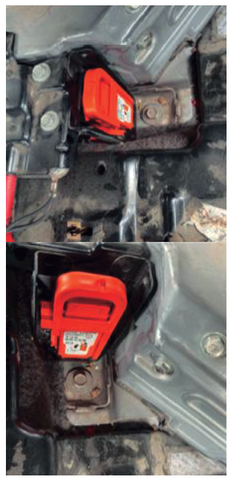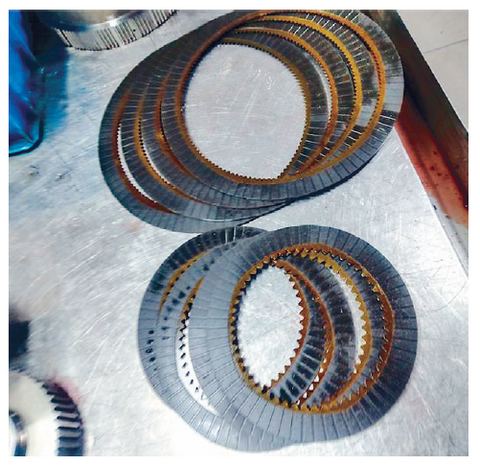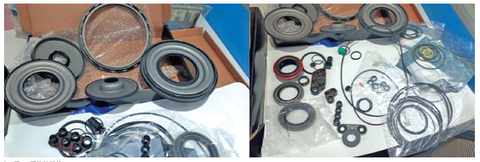[Repair Case] 2009 Cadillac Escalade shuffles when accelerating at medium and low speeds
Posted by Tony Brown on
A 2009 Cadillac Escalade hybrid electric car equipped with a V8 6.0L gasoline engine and matched with a 2ML70 mild hybrid PS structure type transmission.
Driving Mileage: Around 105,600 miles.
Issue: Continuous shuffle when accelerating at medium and low speeds, and the phenomenon is especially obvious just after a sudden acceleration on starting.
Diagnosis: After picking up the car, the customer describes the fault phenomenon and shows that the car is basically normal when it’s cold and the fault is difficult to test. Also, the fault does not occur very frequently when the car is hot, so as to be an occasional failure. In addition, it’s also learned during the consultation session that the customer believed that the failure was caused by the engine problem during the use of the car 4 months ago, so he went to the station to check and finally determined that the scope of the failure should be in the hybrid power system, which should be exhibited by the motor inside the transmission. In this way, the technicians at the station changed the transmission oil again, and at the same time the engine spark plug was also changed, and the throttle valve was cleaned and matched as well, but none was effective. After getting to know the above information, we were not eager to test the car on the road but connected to the diagnostic instrument for vehicle system testing. As a result, we read a P0AC4-00 compound power system control module in the engine system to request a fault code for MIL lighting, at the same time two fault codes were read in the hybrid power system (compound power system), namely P0506-00 idling low and P0AB9-00 compound power system performance.
Fault code analysis: It is easy to analyze the fault code of the P0AC4-00 hybrid power system control module requesting MIL lighting. In fact, it is because the hybrid power system passively requires the engine to turn on the fault light after the hybrid power system fails, so it means that the engine system does not necessarily have a fault. For hybrid power system fault codes, the analysis is not so simple. First of all, the fault code of low idle speed of P0506-00 is fairly easy to understand. It may be caused by insufficient engine power generation capacity of the motor due to low idle speed of the engine. But for the P0AB9-00 composite system performance fault code, although the fault range is in the hybrid system, but for the performance fault code, if there is no problem with the high-pressure system, there may be a problem with the transmission.
2ML70 transmission structure and control characteristics: The test run testing method for the failure phenomenon of hybrid electric vehicles is different from the test run test method of other types of automatic transmissions equipped with fuel vehicles. Therefore, it is necessary to recognize or fully understand the characteristics of this transmission, and then conduct a road test, to have a full cognition and understanding. The hybrid transmission belongs to the PS structure type (motor position). There are 2 electric motors at the front and rear, and there are 2 sets of clutches and 2 sets of brakes, which jointly control 3 sets of single-stage single-row planetary gear sets, helping realize a fixed transmission ratio drive mode, pure electric EV drive mode, hybrid power mode and deceleration brake recovery mode, etc. (transmission diagram is shown in Figure 1).

Motor A is located at the rear end of the mechanical oil pump at the front end of the transmission, and its rotor is connected to the sun gear of the first planetary row and the second row of ring gear. It can start the engine together with the electric motor B and can also realize the power input and power generation process. Therefore, motor A has 3 functions: starter, generator, and drive motor. The electric motor B is in the middle and rear part of the transmission, between the second and third row of planetary rows, and its rotor is connected to the sun gear of the second and third row of sun gears. It can start the engine together with electric motor A, or it can be pure electric (starting in R gear and forward gear) to realize power input and power generation process. Therefore, motor B also has 3 functions: starter, generator, and drive motor. Of course, motor B mainly completes pure electric EV mode drive and hybrid drive with the engine. The combination of 2 sets of clutches, 2 sets of brakes and 3 sets of planetary gear sets can achieve multiple transmission ratios like AT-type transmissions and combined with 2 electric motors can realize the ECVT transmission process. Two of the electric motors are controlled by the hybrid power system, and the clutches and brakes are controlled by the TCM commands 4 linear solenoid valves (the same as the result of the AT transmission control).
After knowing the structure and control features of this hybrid power transmission, we can go for a test drive. First delete the fault code and find out the rules of the failure phenomenon during the test drive: both the pure engine drive mode and the pure electric drive mode have no failure phenomenon described by the customer, and the shuffle only appears in the hybrid mode and the rapid acceleration, and the other is the failure phenomenon of the slope. Test drive experience tells us that this phenomenon is particularly like the lack of oil in the AT transmission. When we returned to the factory, we found a serious lack of oil through the transmission dipstick. At that time, the transmission temperature was around 60°C, but the actual oil level was still below the lower limit, and then less than 2L of new oil was refilled in time, and the failure phenomenon remained the same when it was tested again. The performance of the electric motor will not have the phenomenon of turbulence. Will it be the turbulence caused by the excessive driving torque and the loss of the load capacity of the clutch or brake due to lack of fuel in the hybrid mode? Therefore, in the test run, when the failure occurred, the clutch working curve was found to fluctuate. Therefore, it is believed that even if the clutch and brake ablation cannot be judged from the color and smell of the lubricating oil, it must be the clutch and brake. When a large torque is input, due to the change in the friction coefficient, there is a phenomenon of continuous slight slipping. In this way, the maintenance plan is clear, and the transmission is disassembled for inspection and maintenance.
For hybrid models or plug-in hybrid models, if the transmission is removed, it must also involve the disassembly and assembly of high-voltage cables. The high-voltage power-off switch of the Escalade Hybrid between 2009 and 2013 is located under the right rear seat. Open the plastic cover to see the orange switch (as shown in Figure 2), and then follow the instructions to turn off the switch. Remove the electric switch and keep it, and then re-install the transmission after it is installed in the car.

Troubleshooting: The reason for the lack of oil in the transmission was discovered during the process of dismantling the transmission. It turned out that there was a problem with the oil seal at the rear of the transmission, which caused the transmission oil to flow to the position of the transfer case connecting shell. After disassembling the transmission, it was found that there was no major problem with the four sets of friction plates (as shown in Figure 3), but there were ablation points on one set of steel plates. Replace a set of overhaul kits (friction plates, steel plates, oil seals, etc.), filters, etc. (as shown in Figure 4 and Figure 5). After installation, the test fault is eliminated, and the fault code does not reappear.



Summary: This case is not difficult, but it is a new direction for hybrid electric vehicles. The structure and control principle are different from those of traditional transmissions. Therefore, the performance of the fault phenomenon in the test drive is also very different. At the same time, the interpretation of the fault code also needs to be re-recognized and understood. The main problem of this transmission is that the steel sheet has ablation points due to lack of oil, and the change of the friction coefficient of the friction sheet causes the load torque to be limited, so that the failure phenomenon occurs during rapid acceleration. What was the current drive type of the transmission when the malfunction occurred? Why is it easy to reproduce the fault phenomenon only when the hybrid power is driven by high torque? Why is it in the low starting speed range? Why is it waiting on a slope? Through the analysis of the failure phenomenon, we can quickly approach the point of failure step by step. In addition, the judgment of whether the friction plate is good or bad can never be seen with a pair of eyes. Now it is often caused by the problem of the friction coefficient of the friction plate that causes the failure phenomenon.
